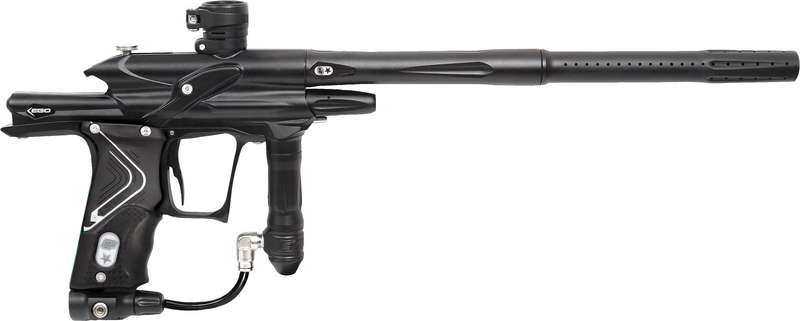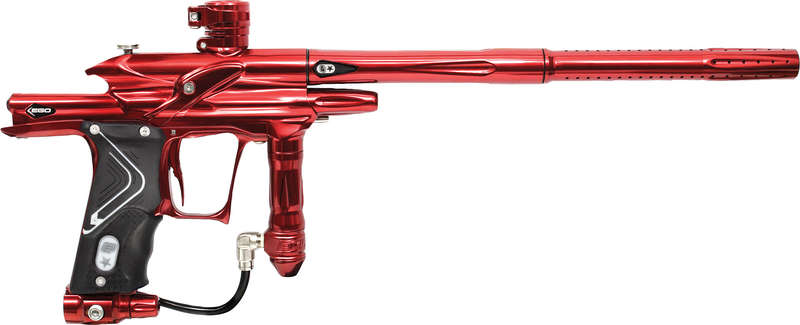Description
Features:
-
Capped and Uncapped Semi and
Ramping Modes -
9 Debounce Modes
-
07 Cure Bolt
-
Direct-Acting Solenoid
-
LCD Display
-
Swivel In-Line Regulator
-
Lever Operated Clamping
Feed -
Shaft II 2-Piece 14â 0.693â
Barrel -
Ultra-Lightweight Monoform
Body -
Deftek Offset Feed Tube
-
Flusher-Fitting Eye Covers
-
Integrated Rammer Housing
-
Integrated FRM
-
Lightweight Rammer
-
Larger Valve Chamber
-
High-Flo Valve
-
Lower Operating Pressure
-
Swivel Stainless Banjo QEV
-
Micro + Opto Switch Board
-
Duel Instrument Grade
Ball-Raced Trigger -
Magnetic Trigger Return
-
Skinny-Fit Co-Moulded
Rubber E-Star Grips -
T-Slot Rail Mounting System
-
-
07 On/Off/Purge System
-
Lower Cyclic Mass
-
Less Kick
-
Quieter Shot
-
Same Excellent Efficiency
-
Low Profile Break-Beam Eyes
Ego 7 Technical
Innovations
The Ego7 sees the culmination of many months of
design, experimentation and testing in the smallest, lightest Ego that Eclipse
have ever produced. Not just a new milling job and some new anodised fancy
colours, the Ego7 has undergone a complete re-design and re-build from the
ground up. Almost every component of the Ego7 has been improved to either
increase performance, reduce size and weight, improve user-maintenance, improve
reliability, or just make it plain better looking.
But it is not just new mechanical components
that you will find in the 07, but new electronic innovations as well. For
example there is a completely new solenoid valve system, as well as new drive
circuitry that have been implemented in order to achieve superior cyclic
consistency and speed.
Solenoid Valve
For the first time in an Eclipse gun we are
using a true âDirect-Actingâ solenoid. What this means in terms of performance
is that the solenoid pulse is far more consistent, far faster, and far more
accurate than a more conventional pilot-operated solenoid valve.
Most solenoid valves used in paintball work off
a âPilotâ system. They rely on air pressure supplied by the LPR to drive the
spool inside the solenoid valve backwards and forwards. Any deviation in LPR
pressure will ultimately effect the speed, duration and accuracy of the
actuation of the spool. And because the actuation of the solenoid valve spool
is what determines the actuation of the rammer and the valve, you can see that
any variation in the pulse from the solenoid valve will ultimately effect
velocity, accuracy and cycle speed.
However, in a direct-acting solenoid valve the
action of the spool is controlled solely by the electromagnetic coil, and a
return spring. So no matter what the pressure and recharge rate of the HP or
LPR supply, the solenoid spool will always actuate fully, extremely accurately,
and for exactly the same duration every time, giving the whole firing cycle the
very best platform from which to achieve the highest possible velocity
consistency. And consistency gives accuracy!
But the performance benefits do not stop there.
Because the solenoid valves electro-magnetic plunger acts directly onto the
spool, and the spool is then returned to its start position by a spring, it means
that the actuation of the spool is faster in both the energising and
de-energising parts of the cycle. That means the solenoid, and hence the air
supply to both sides of the rammer is quicker than a more conventional
pilot-operated valve.
The reason direct-acting solenoid valves are
not widely used in paintball is because they inherently use more electrical
power. It is electromagnetic force doing all the work to drive the spool rather
than air power in other valves. But by utilizing a completely new method of
actuating and driving the solenoid, Eclipse have managed to get the same long
battery life out of this new direct-acting solenoid as you could expect out of
the lesser performing pilot-operated solenoid valve. The new electronics allow
more accurate and efficient drive of the solenoid coil over a far wider range
of supply voltage from the battery. We have managed to achieve the impossible
by getting big performance gains at the cost of no additional power usage.
Circuit Board
Electronically the Ego7 also offers another
paintball first. Over the last 2 years we have noted the split between players
who prefer an optical trigger switch, and those that prefer the more
conventional and comforting âclickâ that you only get from a micro-switch.
Rather than asking one group or another to have to buy an âupgradeâ board just
in order to get their preferred trigger actuation mechanism (and have to lose
the functionality and ease-of-use of the Ego LCD at the same time) we thought
it was only fair that the Ego7 included BOTH trigger actuation systems as
standard on the board. The Ego7 can be configured to run off either the optical
switch OR the micro-switch. Simply select the desired trigger operation in the
software and set your trigger accordingly. The electronics will then
automatically set the corresponding level and type of Debounce for the system
selected.
Multiple Preset ramps modes, plus fully
customizable Ramp modes with either adjustable cap up to 25 BPS or Fully
Uncapped are standard. NPPL, PSP, Millennium modes are preset to make sure you
are fully league compliant, or adjust and customise any mode to suit your
requirements. Of course ROF indicators, shot counter and game timer are also
there, and navigation is made even easier with the inclusion of fully animated
Gifs to guide you along.
Trigger
With the addition of a dual-triggering system
comes an all-new dual ball-raced trigger mechanism. Unlike most bearing trigger
designs where the bearing is simply glued into the trigger, the Ego7 utilizes a
separate bearing carrier mounted into the frame, and like previous Egos, the
trigger pin clamps directly to the trigger. This gives a very wide axial spread
of the side-to-side pivoting action of the trigger, leaving no slop, just a
silky smooth action.
The new trigger combines a magnetic return for
those using the optical trigger switch, or a choice of micro-switch spring and
magnet for those wanting the click of the switch. And obviously switch
activation, pre and post trigger travel and magnetic return strength are all
adjustable directly in the face of the trigger. No need to drop the gun apart
to make any adjustments.
Frame
The new frame now flows and moulds with fluid
lines to the bottom of the main body. This not only allows for smaller, tighter
packaging of the internals, but also allows the top of the hand to move up,
closer to the axial line of the barrel and bolt. This makes the gun feel much
more âpointyâ as the hand comes closer to the sighting-line of the barrel. The
new trigger guard is large enough for either two very big, fat fingers, or for
the now widely-used three-finger technique. And to further add to the ease of
shooting the 07, the trigger has been moved back in the frame and the grip made
shorter from the back edge to the trigger. This combined with a much-requested
slimmer grip, and gives a much more comfortable and ergonomic feel than both
the 05 and 06 Egos.
The current industry standard Dovetail rail
that is used to connect the ASA to the frame has consistently proved to be the
weakest link for every manufacturer out there when it comes to the durability
of the system used to mount the tanks to the guns. So for that reason we have
shunned the flawed design of the dovetail in favour of a T-Slot design. By
using a T-shaped slide rail, as opposed to the double V of the old fashioned
dovetail, the ASA-To-Frame interface has been drastically strengthened. There
should be no way that a well executed dive into a bunker should dislodge the
ASA now, but even if you feel you have to go and use a different ASA there is
still standard mounting holes in the frame to fit your own inferior rail and
ASA. But why would you want to replace it when the 07 OOPS has one of the
lightest actions under gas pressure, includes a downstream dump facility, and
when combined with the 07 frame has over 1.5â of fore-and-aft slide adjustment
to suite virtually any length of arm and size of player?
Internals
Internally there are also some radical changes.
The main difference here is the complete removal of the old rammer housing.
Take a look at the rear body of the Ego7 and you will notice that it is so slim
that it is, in fact, thinner than the already slimmed down frame. Using new
manufacturing techniques the rammer shaft (now also shorter) runs directly in the
body without a sleeve, and the new swivel QEV mounts to the bottom of the body.
By removing the housing we have removed unwanted metal, and reduced the number
of seals required.
And because of the way the rammer now sits in
the body, we have also been able to lighten the weight of the rammer, as well
as reduce the pressure needed to cycle it, and the force it is driven backwards
with. Combined with a shorter, lighter bolt, the reciprocating mass has been
reduced. In doing so we have managed to reduce the kick induced by the bolt and
rammer cycling back and forth.
The valve guide is now much smaller, both in
diameter and length, and combined with the vastly improved size of the valve
chamber, the porting of the new valve guide helps lower the operating pressure
to well below 250psi. This makes the new 07 the lowest operating pressure Ego
ever produced. Lowering the operating pressure generates 3 noticeable benefits.
It not only reduces the pressure of the gas on the paintball, and hence allow
the shooting of more fragile paint, it also allows the shot to be a lot quieter
and the kick to be significantly less.
In order to cope with the enlarged air passages
and internal volume, the valve retaining screw has also been modified, so that
the transfer port between the valve and the bolt chambers could also be
increased to increase flow.
Up front there are still more changes. The FRM
is now integrated into the light weight body. This makes for a lower gun
profile, fewer seals, improved reliability and more sturdy construction. The
small âTorpedoâ between the FRM and LPR body is there to direct the LP air from
the LPR to the solenoid, and is instrumental in providing a body solution that
has NO Loctitied blanking plugs and NO glued in screws.
The Inline regulator is also improved. Now a
swivel design as standard, the new reg incorporates a new piston design that
means the main seal is locked into place. There is now no way that the seal can
become detached from the piston, no matter what daily abuse is thrown at it.
Again, this is a step to improve the performance and reliability of the Ego7.
In the upper tube there is the new Cure bolt,
cut to blend seamlessly with the rear of the body, and provide relief from
breaks caused by over-zealous force-feed loaders and fragile tournament grade
paint. The Cure bolt has been proving its worth through the second half of last
season with all the Eclipse sponsored teams switching to them in order to shoot
the most fragile paint going. Now a standard feature in the 07, it will really
come into itâs own in the colder winter months where other guns and bolts have
been known to struggle.
Barrel
So not just a whole new gun for 07, but an
all-new Shaft II barrel. Using a micro-honed finish and a 2 piece design, we
have kept the popular and unique reverse-thread front-to-back attachment of the
old Shaft, but beefed up the mating threads to allow far superior concentricity
between the 2 sections. Available as standard on the 07 you will find the new
Shaft II in 2-Piece, 14â and 0.693â bore guise. New milling also helps to make
this one of the lightest barrels on the market.
Weight
So what about the weight? Well, letâs just say,
you thought the SL66 was light, right? Well the 07 blows that out of the water.
Side-by-side with a standard Maniac Ego 06, the new Ego weighs over 230grams,
yes
8 OUNCES LESS. 8 OUNCES!!!
Lighter, less kick, quieter signature, more
compact, fewer seals, more reliable, more performance, more features, tighter
profile, better looks, more adjustability, reduced operating pressure, improved
grip ergonomics, easier maintenance etc, etc, etc.
The Ego7
is not just a new milling job, itâs a revelation.
Technical Specifications
All Weights and Measurements Include 14â
Barrel, On/Off/Purge System , Battery etc.
Full Set-Up Ready to Go:
Length: 531mm
Height: 216mm
Width: 26mm
Weight: 941g / 2.07 lbs







Reviews
There are no reviews yet.